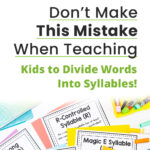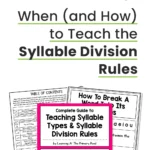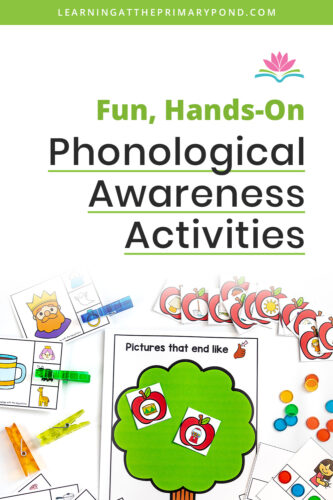Did you know that dividing words into syllables is one of the most powerful decoding strategies?
If your students are ready to read words with more than one syllable, then it’s time to start teaching syllable division rules!
When readers know the syllable division rules, it A) helps them successfully decode unfamiliar words and B) provides them with clues about the vowel sounds in multisyllabic words!
It’s essential that our students understand how English sound and spelling patterns work, and syllables are a big part of that. Knowing how to divide words into syllables gives your kids POWER to attack those long words! This is important to integrate into your phonics instruction.
Knowing more about syllables…
- Helps kids divide words into syllables to decode or write them
- Helps kids predict the sound a vowel makes
- Makes it much easier to break up “big words”
Plus, the Science of Reading research has shown the importance of including multisyllabic word decoding instruction. The vast majority of English words are multisyllabic. They are more difficult to decode because they are long (which can affect one’s working memory in recalling the word parts), and they often contain tricky sounds and spelling patterns (such as different vowel sounds). Explicit instruction in syllabification (dividing words into syllables) improves struggling readers’ multisyllabic word reading accuracy (Heggie and Wade-Woodley, 2017).
In today’s post, I’ll explain how to get your students to read multisyllabic words!
…And I also have something to confess:
Despite being an English speaker, teacher, and avid reader, I did not know these rules until I’d already been teaching for years.
So if these strategies and information are new to you, don’t sweat it! We’re all learning! All the time!
Everything you’re going to see in this blog is from my “Complete Guide to Teaching Syllable Types & Syllable Division,” and you can learn more about that resource here .

The 6 Different Syllable Types
Do you know the 6 syllable types? They are:
- Closed Syllable
- Open Syllable
- Vowel-Consonant-E Syllable (also known as Magic E or Silent E Syllable)
- Vowel Team Syllable (this one is sometimes also split up into 2 syllable types, Vowel Team & Diphthong)
- R-Controlled Syllable
- Consonant-L-E Syllable
If you haven’t read my post that goes in-depth on these syllable types, you may want to read that first, and then come back to this post. My 6 syllable types post can be found HERE!
Finding the Number of Syllables in a Word
An important first step in dividing up long words into their syllables is knowing how many syllables the whole word has.
You may already know that 1 vowel sound = 1 syllable. If a word has 3 vowel sounds, for example, then it has 3 syllables.
(Notice that I’m saying vowel sounds, not actual vowels. The word “cupcake,” for example, technically has 3 vowels. But the e is silent. It only has two syllables because the vowel sounds we hear are the short vowel sound u and the long a, 2 total vowel sounds.)
Syllable Division Patterns
There are only 6 syllable types, and there are even fewer syllable division patterns!
The syllable division patterns are as follows (V = vowel; C = consonant):
VC/CV
If you have two consonant sounds between two vowel sounds, divide the word between the consonant sounds.
In the word “rabbit,” the vowel sounds are the short a and the short i. The two consonants in the middle, b and b, get divided up.
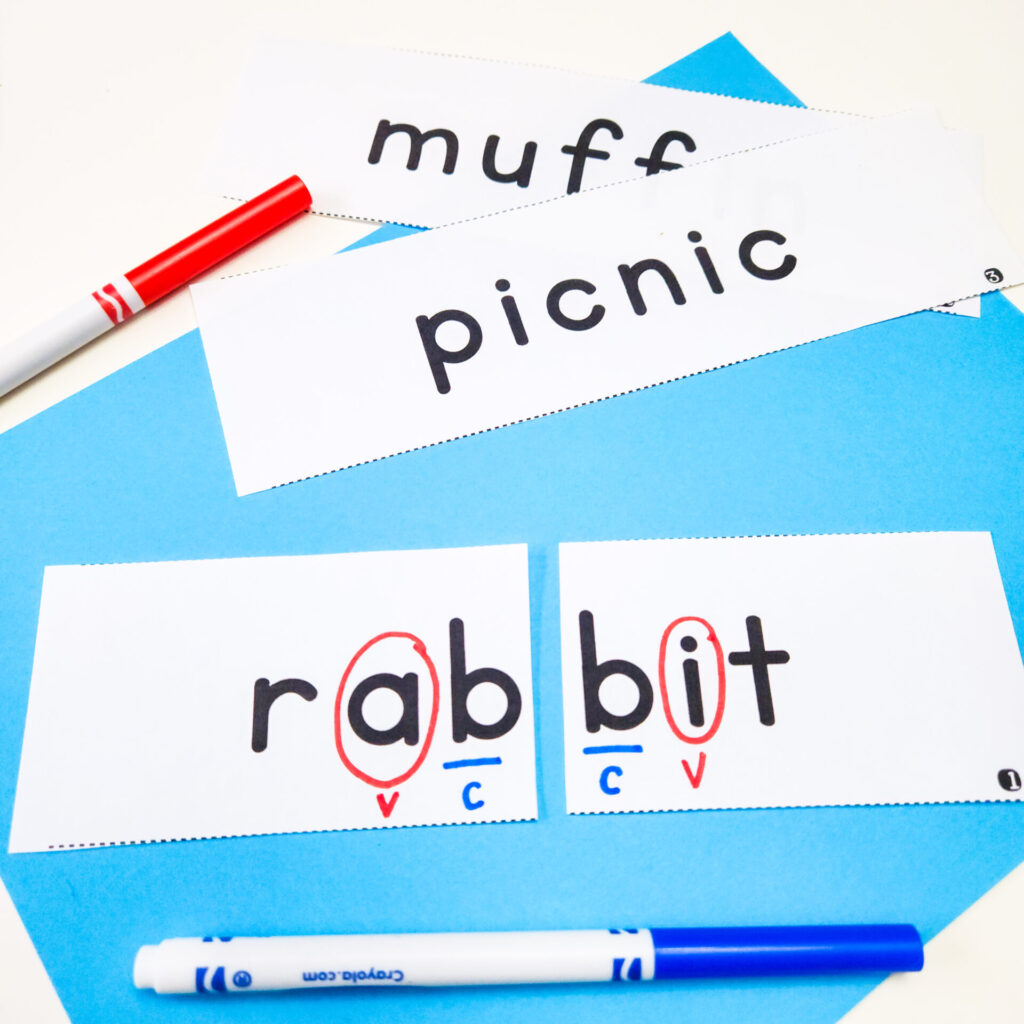
In the word “dishpan,” the vowel sounds are the short i and the short a. The two consonant SOUNDS in the middle are /sh/ and /p/. The word gets divided up between the h and the p.

If there are 3 consonants between the vowels, rather than 2, there’s going to be a blend in there. The sounds that get blended together stay together in one syllable.
For example, in the word “complex,” we divide between the m and the p.
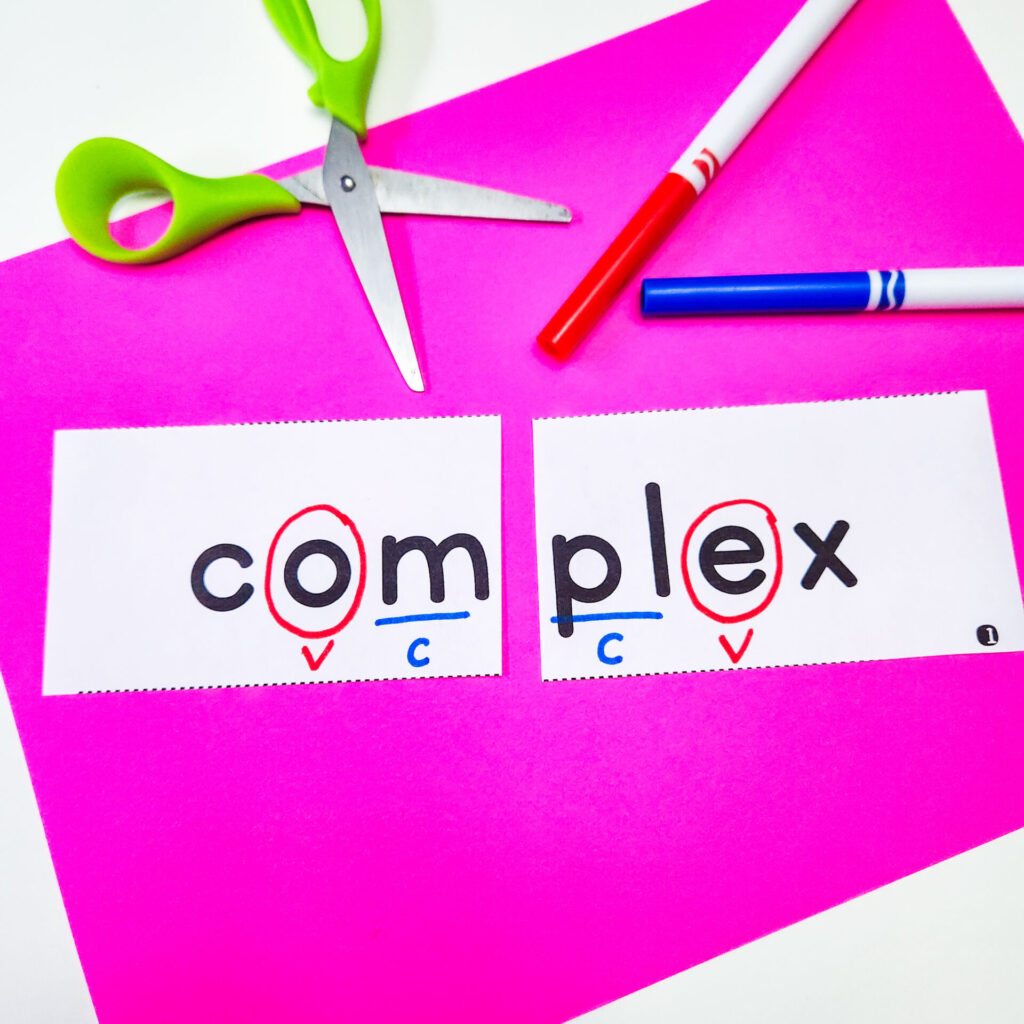
V/CV
Moving on…sometimes there’s just one consonant sound between the vowels, rather than 2.
If this is the case, the first syllable division rule that we try is V/CV (dividing up the word BEFORE the consonant).
For example, in the word “robot,” we divide up the word before the b. This creates an open syllable, “ro,” that ends in a vowel. As a result, the o in that syllable is a long o.
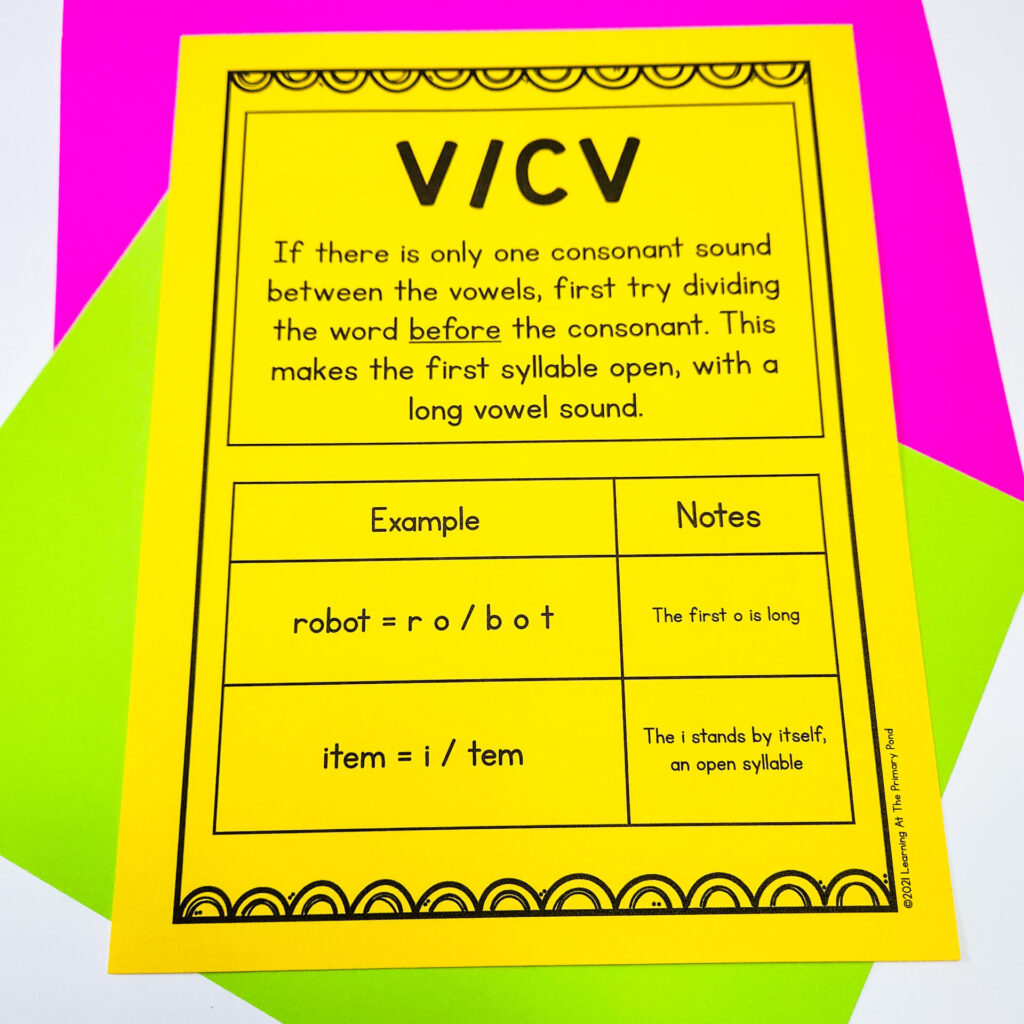
VC/V
However, sometimes the V/CV division rule doesn’t work. This is where it gets a little tricky and we MUST teach our students to be flexible.
If we try the V/CV rule but discover that it creates an open first syllable that should NOT be open (it should not have a long vowel sound, because that doesn’t make a real word), then we have to revert to the VC/V pattern.
For example, let’s think about the word “comet.” It’s pronounced with a short o at the beginning, right? It’s not CO-met. But if we were to apply the V/CV division pattern, that would make the o sound long. Instead, we have to revert to VC/V in order to reflect the fact that the o has the short o sound.

V/V
Last but not least, we have the V/V syllable division rule! When there are two vowels next to each other that do NOT work as a team, then we divide the word between those two separate vowel sounds.
For example, we divide the word “neon” between the e and the o:

However, in a word like “boat,” we do NOT divide between the o and the a. There is only one vowel sound, the long o. Therefore, it’s a one-syllable word, and the o and the a work together to make a single sound. They cannot be divided up into a first and second syllable.
Tips for Teaching Syllable Division Rules to Students
Okay, so….that’s not too bad, right? Once you understand the four syllable division patterns, then you can teach them to your students!
As you probably noticed from the photos in this post, I have my students circle and label the vowels with red, underline and label the consonants with blue, and then cut or draw a line to divide the words. (If it helps, scroll back up through the photos in this post and have a closer look at what I did.) I think this is a great way to help students visually see the individual syllables.
Here’s the procedure:
- Look at the word. Circle the vowel sounds with red.
- Underline the consonants BETWEEN the vowels (don’t worry about the other consonants).
- Determine which syllable division rule (VC/CV, V/CV, VC/V, or V/V) applies. (Students may have to attempt to read the word to choose between V/CV and VC/V.)
- Cut or mark the word accordingly.
- Read the word.
You can also have students code the syllable types after Step #3 (closed, open, VCE, vowel team, r-controlled, or CLE—read more about the syllable types HERE!)
When we’re learning about syllable division and syllable types, we use strips of paper. Students can copy a word I write on the board (or I prepare the word strips for them ahead of time).
I don’t read the word to them, because the purpose of the division exercise is to get them to break up the word and read it.
Once they’ve copied the word, then we go through Steps 1-5 listed above, and students can cut the word in half.
The ultimate goal of this exercise is to get students to break up multisyllabic words as they read. So, as a bridge between this activity and reading, we use whiteboards or sticky notes to divide up tricky words they encounter in texts.
If I’m working one-on-one with a student and they come to a tricky word, we can write it on a small whiteboard and then break it up.
If students are working on their own, they can write a tricky word on a sticky note, divide it up, read it, and then continue reading.
This does slow down the reading process a little, but I’m telling you…kids feel SO powerful when they can break up words and determine what types of syllables they have. This process also makes it easier for students to figure out the vowel sounds in a word.
When to Teach This Stuff
You might be wondering, “When should I teach these rules for multisyllabic word reading? At what developmental stage or grade level are these appropriate?” Many phonics curriculum programs for Kindergarten, 1st grade, and 2nd grade do not include this… so it’s important to add in this explicit instruction!
When to teach the VC/CV rule:
Whenever kids have mastered CVC words, they can read 2-syllable words!
Simple compound words are a great place to start. You’ll want to use a compound word like “sunset” which is 2 CVC words “put together.” At this point, you can teach students the VC/CV rule. You can also explain that both of the syllables in those words are closed and have short vowels.
I don’t normally teach this in Kindergarten, but if I have more advanced students who are truly proficient with CVC words and ready for more complex words, then it makes sense to give them “access” to these simple 2-syllable words.
Of course, if you give students words with consonant digraphs or blends in between, then it becomes a little more complicated—early first grade may be a better time for those more complicated VC/CV words.
When to teach the V/CV and VC/V rules:
I teach the V/CV rule first, because we always try the V/CV pattern before reverting to VC/V.
You can teach this rule once students know about the long vowel sounds.
They don’t need to have completely mastered long vowels and all their letter patterns for spelling. But they do need to understand the concepts of open syllables and closed syllables (and how short and long vowels relate to open and closed syllables).
When we’re working on the V/CV rule, I intentionally only give them practice words that follow that rule.
After they understand the V/CV rule, then I explain that sometimes we have to use the VC/V rule instead.
I then give them VC/V words to practice.
Finally, I give them mixed sets of words where they have to choose between V/CV and VC/V.
When to teach the V/V rules:
I wait to teach V/V until students really understand vowel teams and diphthongs.
If students don’t understand vowel teams, then they may try to divide up words like “train” into two syllables, between the a and the i. If they don’t understand diphthongs, they may try to divide up words like “loud” into two syllables.
Once they know the vowel teams and diphthongs, however, they’re more likely to recognize that words like “fluent” have two vowel sounds, not one, and we divide up the word accordingly (flu/ent).
Conclusion
This was a lot of info, right?! And it’s a lot to figure out and teach on your own – especially if you don’t have lesson plans and materials for these foundational skills. This content is applicable for the young readers who are just mastering CVC word recognition to struggling readers who need support with longer words. Helping your students identify a process for decoding multisyllabic words will increase students’ ability to decode unknown words! It also aids in writing as students will know correct spelling rules when it comes to multisyllabic words.
If you’d like to make teaching this EASY and FUN for you and your students, check out my step-by-step guide to teaching all the syllable division rules and syllable types. (This also includes a multisyllabic word list for each syllable type so you don’t have to go digging for word lists!)
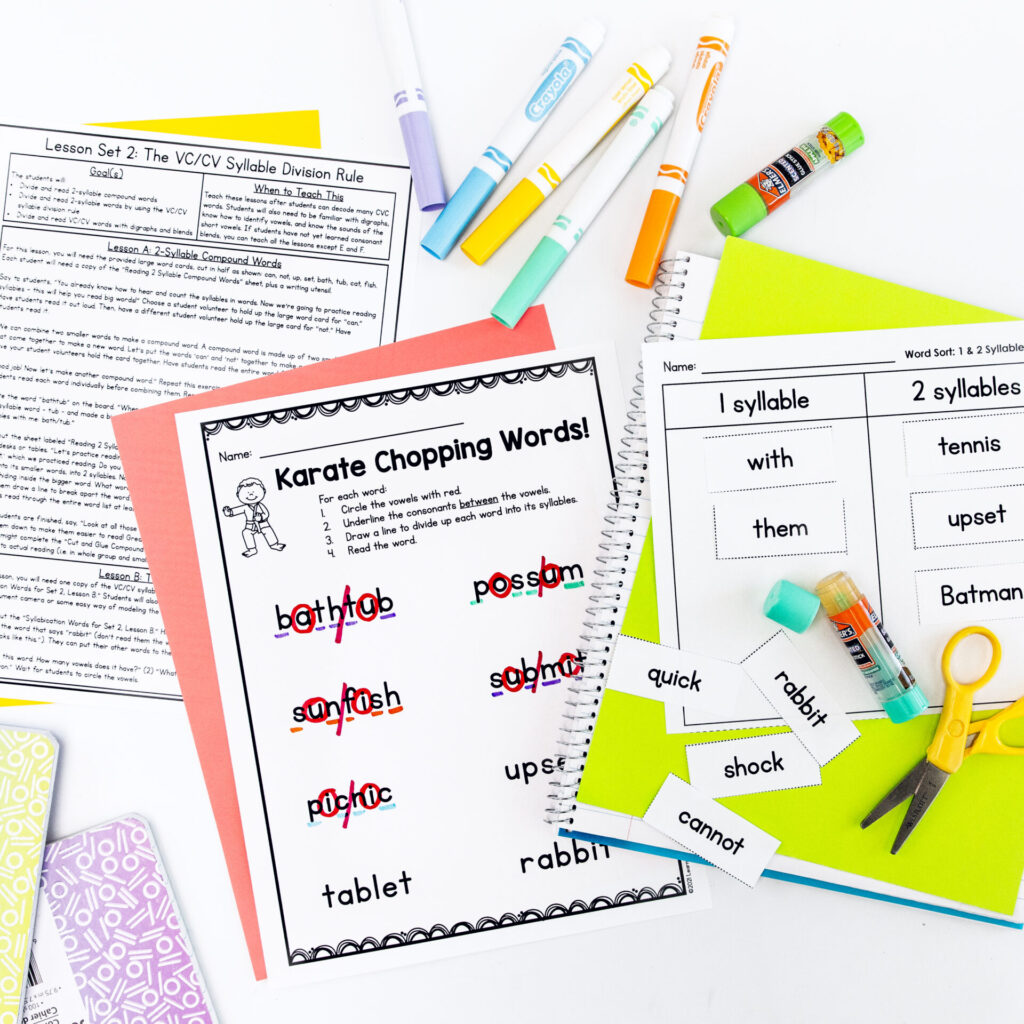
My “Complete Guide to Teaching Syllable Types & Syllable Type Division” includes:
- Complete, detailed lesson plans (30 lessons total) with step-by-step directions
- Posters and visuals for the syllable types, syllable division rules, and multisyllabic word reading process
- Word strips and half-sheet options with words for students to practice dividing
- Syllable sorts, puzzles, worksheets, and activities for follow-up practice
- Video link with examples of how to teach syllable division
Please let me know if you have any questions about anything I’ve shared here! If you want to save this post for later, here’s an image you can pin to your Pinterest account:
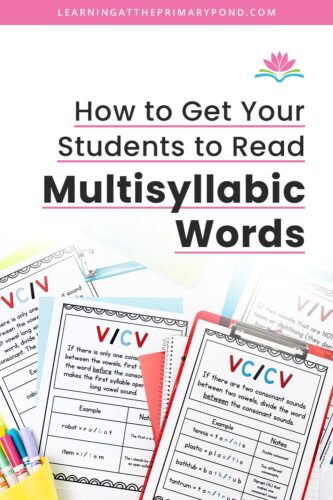
Happy teaching!


